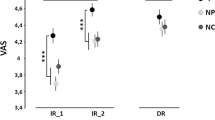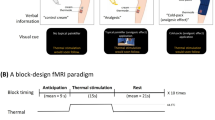Abstract
Pleasant imagery and focusing on pleasant slides have been found to be effective in increasing pain tolerance during noxious stimulation. However, since studies have not systematically varied the affective quality of the imagery or slides, there has been no way of determining whether the affective quality of the techniques is critical to their effectiveness. This study intended to examine the role of the affective quality of slides by using both pleasant and unpleasant scenes. One-half of the subjects also received a recall task that demanded added concentration, and thus increased the amount of distraction offered by the slides. The experiment consisted of a 2 ×2 design: pleasant versus unpleasant slides, recall versus no recall. There was also a control group, which received no slides or task. Subjects were 64 females recruited through undergraduate psychology courses and the university newspaper. The noxious stimulation was a cold pressor consisting of an enameled metal pan filled with ice water. The dependent variable was the length of time a subject kept her hand in the water. Chi-square tests corrected for continuity found that the unpleasant slides significantly increased the number of subjects who could tolerate the cold pressor test for the maximum time of 300 seconds as compared to the number of subjects in the pleasant slide conditions (χ 2 =10.15, p <.005) and the control group (χ 2 =5.076, p <.025).
Similar content being viewed by others
References
Beecher, H. K. (1975). Quantification of the subjective pain experience. In M. Weisenberg (Ed.),Pain: Clinical and experimental perspectives. St. Louis: C. V. Mosby.
Berger, S., & Kanfer, F. H. (1975). Self-control: Effects of training and presentation delays of competing responses on tolerance of noxious stimulation.Psychological Reports, 37 1312–1314.
Blitz, B., & Dinnerstein, A. J. (1971). Role of attentional focus in pain perception: Manipulation of response to noxious stimulation by instructions.Journal of Abnormal Psychology, 77 42–45.
Bobey, M. J., & Davidson, P. O. (1970). Psychological factors affecting pain tolerance.Journal of Psychosomatic Research, 14 371–376.
Chaves, J. F., & Barber, T. X. (1974). Cognitive strategies, modeling and suggestion in attenuation of pain.Journal of Abnormal Psychology, 83 356–363.
Crimm, L., & Kanfer, F. H. (1976). Tolerance of aversive stimulation.Behavior Therapy, 7 593–601.
Horan, J. J., & Dellinger, J. K. (1974). “In vivo” emotive imagery: A preliminary test.Perceptual and Motor Skills, 39 359–362.
Kanfer, F. H., & Goldfoot, D. A. (1966). Self-control and tolerance of noxious stimulation.Psychological Reports, 18 79–85.
Kanfer, F. H., & Seidner, M. L. (1973). Self-control: Factors enhancing tolerance of noxious stimulation.Journal of Personality and Social Psychology, 25 381–389.
Melzack, R. (1973).The puzzle of pain. New York: Basic Books.
Murray, F. S., & Hagan, B. C. (1975). Pain threshold and tolerance of hands and feet. In M. Weisenberg (Ed.),Pain: Clinical and experimental perspectives. St. Louis: C. V. Mosby.
Murray, F. S., & Safferstone, J. F. (1970). Pain threshold and tolerance of right and left hands.Journal of Comparative and Physiological Psychology, 71 83–86.
Scott, D. S., & Barber, T. X. (1977). Cognitive control of pain: Affects of multiple cognitive strategies.Psychological Record, 2 373–383.
Scott, D. S., & Leonard, C., Jr. (1978). Modification of pain threshold by the covert reinforcement procedure and a cognitive strategy.Psychological Record, 28 49–57.
Worthington, E., Jr. (1978). The effects of imagery content, choice of imagery content, and self-verbalization on the self-control of pain.Cognitive Therapy and Research, 2 225–240.
Author information
Authors and Affiliations
Additional information
This study was conducted at the University of Oregon.
Rights and permissions
About this article
Cite this article
Greenstein, S.M. Pleasant and unpleasant slides: Their effects on pain tolerance. Cogn Ther Res 8, 201–209 (1984). https://doi.org/10.1007/BF01173044
Issue Date:
DOI: https://doi.org/10.1007/BF01173044




